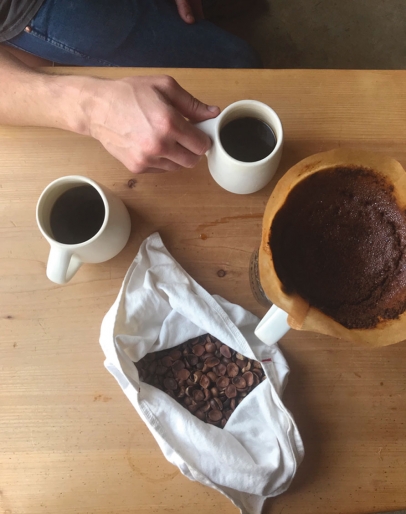Abundant Local Bay Nuts Offer a Natural Buzz
THE HARD INNER seeds of bay nuts, the fruit of the California bay laurel, lend the tree one of its common nicknames: pepperwood. Hidden inside a fleshy, fatty berry that is edible raw only when very ripe because of its abundant and pungent oils, the seeds may be removed and roasted to a flavor reminiscent of dark chocolate and coffee, bitter to almost sour, with a hint of nut—and pepper. The seeds themselves are sometimes referred to as “pepper nuts,” as well as “buzz nuts,” hinting at their mildly stimulating effect.
Bay nuts begin to ripen in late September, and their season may continue through December in their native region. Watch for the once bright green, plump fruits (if you think they look like miniature avocados, that’s because they do—the trees are related) to turn reddish-purple and begin to shrivel a bit and you’ll know they are close to ready.
The bay laurel does not bear fruit every year, and some fruiting years are better than others. This year seems to be poised for a bumper crop.
Gather bay nuts once they have fallen from the tree. The now-reddish- purple outer flesh will have softened considerably, so that it is easily peeled away. I suggest doing this in the field as you gather, to avoid the mess at home. Discard any moldy peels or cracked nutshells.
Wash the hulled nuts with plain water, then dry them with a towel before spreading on a baking pan in a single layer. Place the tray of nuts in the sun (outside, if possible, or by a window) to allow them to completely dry prior to roasting. This generally takes a couple of weeks, but keep checking.
Roast the sun-dried nuts on a baking pan in a single layer at 350°F for 30–60 minutes. After 30 minutes, check the nuts by cracking the shell of a single nut and noting the color and taste (once it has cooled). Continue roasting and checking every 15 minutes, until the desired color and flavor are achieved. My preference is for a medium-roasted nut that reaches a deep caramel-mahogany color. It may take you a few seasons to find your own perfect roast, but I find the opportunity to hone and refine every year part of the pleasure.
Allow the roasted nuts to cool, then store in a sealed glass jar. They will keep for years, a pantry staple ready whenever you need them.
When you are ready to use the nuts, shell them with a nutcracker. Roasted and shelled bay nuts may be nibbled out of hand, or ground and used as a flavorful addition to sauces, baked goods and beverages. Just remember their “buzzy” nickname and take care not to overdo it!
I have experimented using bay nuts instead of more traditional nuts in Tartine Bakery’s 50/50 Sable Cookie recipe, and made my own bay nut–chocolate bars, but most often at home we enjoy adding ground bay nuts to our coffee. The rich, fatty, nuttiness complements the acidity of coffee, rounding the body and mouthfeel, while the peppery, chocolatey notes add depth and complexity to the flavor.
To make your own locally grown and foraged Buzz Nut Coffee, mix equal parts coarsely ground roasted bay nuts with your favorite ground coffee and brew using your preferred method.





